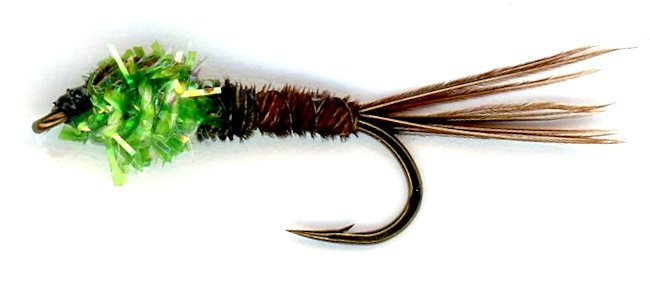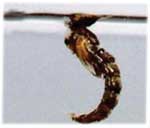The Green Crystal Pheasant Tail Nymph Fly
The green crystal used on this Pheasant Tail nymph fly pattern helps reflect light and brings it quickly to the attention of any nearby lurking hungry trout or grayling.

PHEASANT TAIL FLY PATTERNS. Hook size 12 14 16 18 - $US each
Down in the depths of the river near the bottom it can get slightly murky especially after a good rain storm. This is when the Green Crystal Pheasant tail nymph works well as the crystal fibers help reflect any light to make it more noticeable to any lurking trout. Even when the water is clear the reflective qualities of this nymph pattern help brings its presence to the attention of nearby hungry fish faster than a standard pattern. I have found they are not so good on really bright sunny days as the amount of reflection coming off the thorax is unnaturally bright. As we don't get many of those good sunny days in Britain it is a popular all year round nymph fly that catches its fair amount of fish when deployed with other flies in a team.
The most famous expert nymph flyfisherman, who spent many years experimenting on the Wiltshire River Avon, is of course Frank Sawyer. At the age of 20, he became the under keeper to Frederick Martin, who at that time was the head keeper employed by Lt Col Bailey, who was the owner of a number of fishing beats. Frank was born at Bulford in 1906. When he was 22 he took over as head keeper of the officers fishing association on the River Avon. He remained in this position for the rest of his life. He was on the water everyday winter and summer. It provided him with an excellent natural laboratory in which to experiment with different artificial nymphs that he had designed and constructed. He could also observe the way different tactics worked in certain situations. In 1958 he produce a book on the subject called "Nymphs and the trout". Try to find a copy in a second-hand bookshop. It's a good read and something of a collectors piece. It was revised in 1970 and I think a number of different editions exist.

Both the grandfather of nymph fishing G.E.M Skues, and Frank Sawyer spent a lot of time in the study of the nymph. The emergent nymph in the upper section of the water column was of particular interest to Skues, where as Sawyers interest usually concerned the bottom dwelling deep sunk nymph. G.E.M Skues needed a fly that imitated the silhouette of these crawling aquatic insects, but one that also had great sinking properties so that it could get down to the depth required fast. If the dressing on the body was too big or fibrous it would have problems cutting through the water. This is why he's pheasant tail nymph succeeds so well. Most up-winged mayflies when in the nymph stage have a slim body and along thin forked tail. There is a slight bulge near the head which houses the developing wing case. Skues' pheasant tail nymph flyfishing pattern imitates these natural features so well.
THE MAYFLY NYMPH STAGE
After hatching from the egg the nymph lives and feeds on the bottom. Some are eaten at this stage by foraging trout. Nymphs are also taken as they swim towards the surface. These can be found in ponds, streams, lakes and rivers. They vary in appearance depending on the habitat they have adapted to live in. Most have three tails. Some have long legs for swimming whilst those in faster moving water have short strong legs for crawling.
THE MAYFLY DUN STAGE
At the surface the dun emerges from the nymph stage as it sheds it's old skin. Although winged it is not yet sexually mature, and it must cast its skin one more time to become a spinner. Mayflies are unique in having a pre-adult winged stage. They are the only insects that molt again after they have developed functional wings. This stage is called subimago but more commonly known to fly fishermen as the Dun stage. The nymphs can molt between 12 to 50 times and take over 2 years before they reach the adult stage. Fully grown nymphs rise to the surface and molt into the subimago or Dun stage. This is the most dangerous time for any mayfly as they are easy prey for fish from below and dragon flies from above. To reduce the chances of any single animal being seen or eaten mass emergences take place at dawn and dusk. The dull colored and slightly hairy Dun subimago can be found fluttering to nearby vegetation.
THE MAYFLY ADULT SPINNER STAGE
The final molt to the hairless, shiny-winged adult form takes place a couple of minutes after emerging or a couple of days after. The adults are known as spinners and their main task is to mate in the little time they have left. Males die shortly after mating and the females die after laying her eggs. After mating the female drops egg masses into the water. Some species land on the water surface to perform this function where they are sucked up by hungry waiting trout. Other females enter the water and swim down to attach their eggs to submerged objects.
THE MAYFLY ADULT SPENT STAGE
The dead and dying mayflies are called spent spinners. They are easy prey for the trout.


Fly Fishing books

